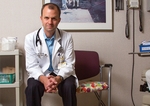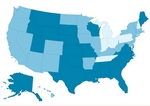business
Retail clinics look to health reform to boost business
■ With more patients becoming insured, clinic chains expect to gain patients from crowded primary care physician offices.
By Pamela Lewis Dolan — Posted May 10, 2010
- WITH THIS STORY:
- » Related content
Retail clinics, whose growth has failed to live up to their initial hype, are seeing an opportunity to expand, thanks to health system reform.
The nation's largest retail clinic chain, CVS-owned MinuteClinic, said it could double its locations in five years, while Walgreen-owned Take Care Clinics said it expects to grow as well. "Health care reform is a positive development for retail clinics, because there are about 30 million people who are currently uninsured who will have health care coverage," Andrew Sussman, MD, president of MinuteClinic, said in an e-mailed statement to American Medical News. "Add to that the aging of the population and the shortage of primary care practitioners, and the opportunity for services such as those provided by MinuteClinic has the potential for growth."
Gregory Wasson, president and CEO of Walgreen Co., said during a recent earnings call that he expects health reform to have a positive impact on business that could create a demand for additional clinics and additional services offered at the clinics. Take Care spokesman Gabriel Weissman said the company would be "thoughtful in our expansion plans" to attract the newly insured patients. He did not say if the company has a specific number of new clinics in mind.
This is the first major talk of expansion from any retail clinic group in several years.
After MinuteClinic reached its goal of 400 clinics by the end of 2007, it said its next goal was to reach 2,500 stores. It never made it past 600.
In 2009, MinuteClinic shut 89 of its clinics, claiming that the seasonality of the business had taken its toll. It planned to reopen those clinics, but many remained closed through flu season.
Meanwhile, Take Care said in 2007 it was on track to open 400 clinics by the end of 2008. It never broke 350.
Overall, the industry has never exceeded the 1,200 mark ,with the total number of retail clinics in the U.S. hovering around 1,100 for the past year. From month to month, a handful of clinics close and a handful open. As of April 1, there were 1,171 retail clinics in operation.
Tom Charland, president and CEO of Merchant Medicine, a Shoreview, Minn.-based retail clinic consultancy firm, said he was surprised that MinuteClinic made such an aggressive statement about growth. He said he thinks reform will help the retail clinic industry somewhat, but he doesn't think it will be as big of a boon as some in the industry think.
The patient breakdown of clinic patients is 80% insured and 20% uninsured, he said, which roughly matches national rates for insurance coverage.
"So are the people they are currently seeing who are uninsured going to become insured? Probably. And are they still going to be coming to the retail clinics? Probably. But do we count those as new patients? No. They are already coming to you," he said. "We shouldn't get too far ahead of ourselves."
However, the clinic industry as a whole still expects business to increase.
"We do expect a positive impact on the industry as different elements of the health reform legislation go into effect," said Tine Hansen-Turton, executive director of the Convenient Care Assn., a trade group for retail clinic operators. "As many millions more Americans will be insured ... we will need to, as a society, support the expansion of access points."












